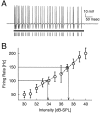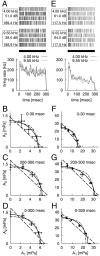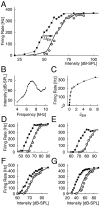Energy integration describes sound-intensity coding in an insect auditory system
- PMID: 12451143
- PMCID: PMC6758769
- DOI: 10.1523/JNEUROSCI.22-23-10434.2002
Energy integration describes sound-intensity coding in an insect auditory system
Abstract
We investigate the transduction of sound stimuli into neural responses and focus on locust auditory receptor cells. As in other mechanosensory model systems, these neurons integrate acoustic inputs over a fairly broad frequency range. To test three alternative hypotheses about the nature of this spectral integration (amplitude, energy, pressure), we perform intracellular recordings while stimulating with superpositions of pure tones. On the basis of online data analysis and automatic feedback to the stimulus generator, we systematically explore regions in stimulus space that lead to the same level of neural activity. Focusing on such iso-firing-rate regions allows for a rigorous quantitative comparison of the electrophysiological data with predictions from the three hypotheses that is independent of nonlinearities induced by the spike dynamics. We find that the dependence of the firing rates of the receptors on the composition of the frequency spectrum can be well described by an energy-integrator model. This result holds at stimulus onset as well as for the steady-state response, including the case in which adaptation effects depend on the stimulus spectrum. Predictions of the model for the responses to bandpass-filtered noise stimuli are verified accurately. Together, our data suggest that the sound-intensity coding of the receptors can be understood as a three-step process, composed of a linear filter, a summation of the energy contributions in the frequency domain, and a firing-rate encoding of the resulting effective sound intensity. These findings set quantitative constraints for future biophysical models.
Figures








Similar articles
-
Spike-train variability of auditory neurons in vivo: dynamic responses follow predictions from constant stimuli.J Neurophysiol. 2005 Jun;93(6):3270-81. doi: 10.1152/jn.00758.2004. Epub 2005 Feb 2. J Neurophysiol. 2005. PMID: 15689392
-
Encoding of amplitude modulations by auditory neurons of the locust: influence of modulation frequency, rise time, and modulation depth.J Comp Physiol A Neuroethol Sens Neural Behav Physiol. 2011 Jan;197(1):61-74. doi: 10.1007/s00359-010-0587-4. Epub 2010 Sep 24. J Comp Physiol A Neuroethol Sens Neural Behav Physiol. 2011. PMID: 20865417 Free PMC article.
-
Temporal integration at consecutive processing stages in the auditory pathway of the grasshopper.J Neurophysiol. 2015 Apr 1;113(7):2280-8. doi: 10.1152/jn.00390.2014. Epub 2015 Jan 21. J Neurophysiol. 2015. PMID: 25609104 Free PMC article.
-
[Conversion of sound into auditory nerve action potentials].HNO. 2016 Nov;64(11):808-814. doi: 10.1007/s00106-016-0258-z. HNO. 2016. PMID: 27785535 Review. German.
-
Modeling the auditory scene: predictive regularity representations and perceptual objects.Trends Cogn Sci. 2009 Dec;13(12):532-40. doi: 10.1016/j.tics.2009.09.003. Epub 2009 Oct 12. Trends Cogn Sci. 2009. PMID: 19828357 Review.
Cited by
-
Disentangling sub-millisecond processes within an auditory transduction chain.PLoS Biol. 2005 Jan;3(1):e8. doi: 10.1371/journal.pbio.0030008. Epub 2005 Jan 4. PLoS Biol. 2005. PMID: 15660161 Free PMC article.
-
Burst firing is a neural code in an insect auditory system.Front Comput Neurosci. 2008 Jul 10;2:3. doi: 10.3389/neuro.10.003.2008. eCollection 2008. Front Comput Neurosci. 2008. PMID: 18946533 Free PMC article.
-
Channel noise from both slow adaptation currents and fast currents is required to explain spike-response variability in a sensory neuron.J Neurosci. 2012 Nov 28;32(48):17332-44. doi: 10.1523/JNEUROSCI.6231-11.2012. J Neurosci. 2012. PMID: 23197724 Free PMC article.
-
Adaptive stimulus optimization for sensory systems neuroscience.Front Neural Circuits. 2013 Jun 6;7:101. doi: 10.3389/fncir.2013.00101. eCollection 2013. Front Neural Circuits. 2013. PMID: 23761737 Free PMC article. Review.
-
The iso-response method: measuring neuronal stimulus integration with closed-loop experiments.Front Neural Circuits. 2012 Dec 19;6:104. doi: 10.3389/fncir.2012.00104. eCollection 2012. Front Neural Circuits. 2012. PMID: 23267315 Free PMC article.
References
-
- Adam J, Myat A, Le Roux I, Eddison M, Henrique D, Ish-Horowicz D, Lewis J. Cell fate choices and the expression of Notch, Delta and Serrate homologues in the chick inner ear: parallels with Drosophila sense-organ development. Development. 1998;125:4645–4654. - PubMed
-
- Barlow R. Statistics. Wiley; New York: 1989.
-
- Benda J. PhD thesis. Humboldt University Berlin; 2002. Single neuron dynamics—models linking theory and experiment.
-
- Benda J, Bethge M, Hennig M, Pawelzik K, Herz AVM. Spike-frequency adaptation: phenomenological model and experimental tests. Neurocomputing. 2001;38–40:105–110.
-
- Bermingham NA, Hassan BA, Price SD, Vollrath MA, Ben-Arie N, Eatock RA, Bellen HJ, Lysakowski A. Math1: an essential gene for the generation of inner hair cells. Science. 1999;284:1837–1841. - PubMed
Publication types
MeSH terms
LinkOut - more resources
Full Text Sources
Research Materials
